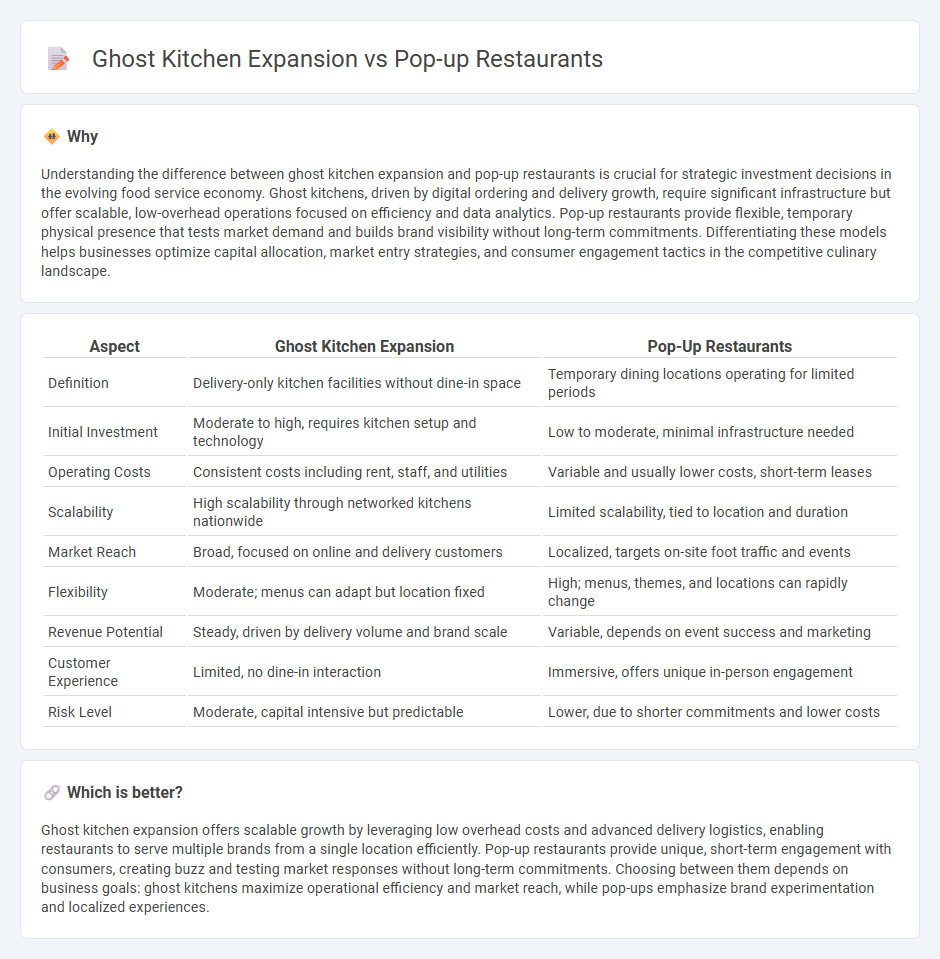
Ghost kitchens, also known as virtual kitchens, are rapidly expanding due to lower overhead costs and increasing demand for delivery-only food services, offering scalable opportunities for restaurateurs. Pop-up restaurants provide flexible, temporary dining experiences that allow businesses to test markets and build brand awareness with minimal investment. Explore the economic impacts and strategic advantages of these innovative food service models to understand their growing influence in the marketplace.
Why it is important
Understanding the difference between ghost kitchen expansion and pop-up restaurants is crucial for strategic investment decisions in the evolving food service economy. Ghost kitchens, driven by digital ordering and delivery growth, require significant infrastructure but offer scalable, low-overhead operations focused on efficiency and data analytics. Pop-up restaurants provide flexible, temporary physical presence that tests market demand and builds brand visibility without long-term commitments. Differentiating these models helps businesses optimize capital allocation, market entry strategies, and consumer engagement tactics in the competitive culinary landscape.
Comparison Table
| Aspect | Ghost Kitchen Expansion | Pop-Up Restaurants |
|---|---|---|
| Definition | Delivery-only kitchen facilities without dine-in space | Temporary dining locations operating for limited periods |
| Initial Investment | Moderate to high, requires kitchen setup and technology | Low to moderate, minimal infrastructure needed |
| Operating Costs | Consistent costs including rent, staff, and utilities | Variable and usually lower costs, short-term leases |
| Scalability | High scalability through networked kitchens nationwide | Limited scalability, tied to location and duration |
| Market Reach | Broad, focused on online and delivery customers | Localized, targets on-site foot traffic and events |
| Flexibility | Moderate; menus can adapt but location fixed | High; menus, themes, and locations can rapidly change |
| Revenue Potential | Steady, driven by delivery volume and brand scale | Variable, depends on event success and marketing |
| Customer Experience | Limited, no dine-in interaction | Immersive, offers unique in-person engagement |
| Risk Level | Moderate, capital intensive but predictable | Lower, due to shorter commitments and lower costs |
Which is better?
Ghost kitchen expansion offers scalable growth by leveraging low overhead costs and advanced delivery logistics, enabling restaurants to serve multiple brands from a single location efficiently. Pop-up restaurants provide unique, short-term engagement with consumers, creating buzz and testing market responses without long-term commitments. Choosing between them depends on business goals: ghost kitchens maximize operational efficiency and market reach, while pop-ups emphasize brand experimentation and localized experiences.
Connection
Ghost kitchen expansion drives cost-effective market entry by leveraging underutilized commercial spaces, while pop-up restaurants complement this trend by testing demand with minimal investment and flexibility. Both models prioritize delivery and digital ordering, fueling growth in the on-demand food economy and reshaping urban foodservice landscapes. Their synergy accelerates innovation in restaurant operations, amplifies consumer reach, and enhances revenue streams in dynamic economic environments.
Key Terms
Overhead Costs
Pop-up restaurants significantly reduce overhead costs by eliminating long-term lease commitments and minimizing staff expenses, focusing on temporary, high-impact dining experiences. Ghost kitchens incur moderate fixed overhead with dedicated commercial kitchen spaces but benefit from streamlined operations and delivery-only models that cut down front-of-house costs. Explore detailed comparisons to optimize your food business strategy effectively.
Scalability
Pop-up restaurants offer limited scalability due to temporary locations and localized marketing efforts, restricting their growth potential. In contrast, ghost kitchens operate without physical dining spaces, allowing rapid expansion across multiple markets with lower overhead costs and more efficient resource allocation. Discover how scalability influences business strategy in the evolving food service industry.
Market Penetration
Pop-up restaurants offer rapid market penetration by creating buzz and testing new locations with minimal investment, attracting curious customers through exclusive, temporary dining experiences. Ghost kitchens enhance market reach by leveraging delivery platforms and optimized kitchen operations, enabling scalable expansion without the high costs of traditional storefronts. Explore how these models can strategically boost your brand presence and customer base.
Source and External Links
Pop-up restaurant - Wikipedia - A pop-up restaurant is a temporary dining concept often set in private homes, former factories, or existing restaurants, popular since the 2000s as a low-cost way for chefs to gain exposure and experiment without bankruptcy risk.
What Is a Pop-Up Restaurant & How To Start One - Pop-up restaurants are temporary, often unconventional eateries that have grown in popularity worldwide, attracting food lovers and chefs who seek creative and flexible dining experiences typically tracked via social media.
What is a Pop-Up Restaurant & How to Open One - Pop-up restaurants can take many forms, such as seasonal or themed events, and serve as testing grounds for chefs to explore menus, build communities, and expand their culinary ventures in venues like bars, theaters, or shared kitchens.
 dowidth.com
dowidth.com